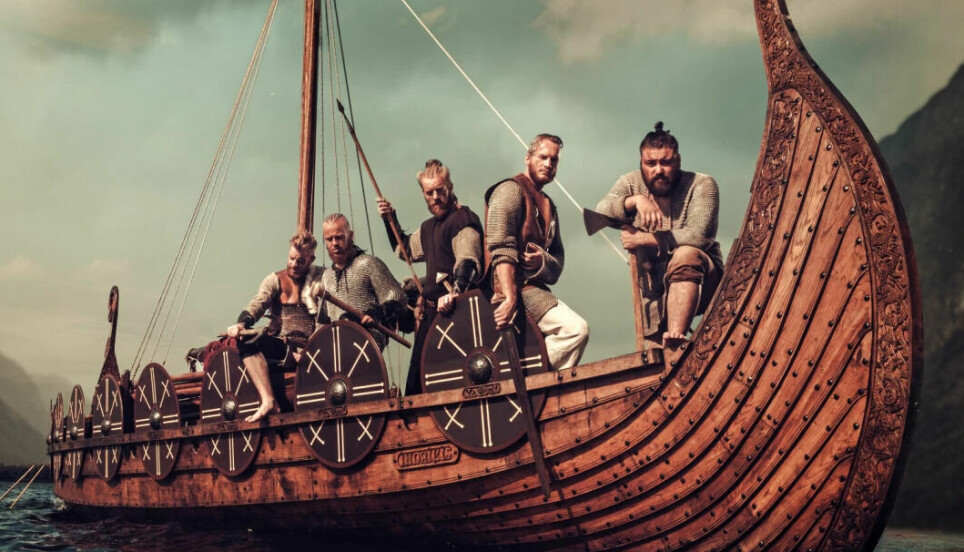
The Vikings traveled a lot. How did they manage to talk to people?
How did they communicate without learning languages in school or having access to dictionaries?
The Vikings learned neither English, German nor French at school. They didn’t have access to Google translate.
Still, they sailed out into the world, bartered, and traded.
How did they talk to people on their travels?
Tempted by silk and spices
“For Vikings who were only supposed to fight and steal, language was not that important,” Elise Kleivane says.
She is an associate professor in literacy at the University of Oslo.

But many Vikings did a lot of other things. Foreign countries had tempting items such as jewellery, silk and spices, which the Vikings wanted to buy and trade for themselves.
“So they had to talk to each other somehow,” Kleivane says.
Pointed and used their hands
The Vikings faced some challenges. There were no schools, and there are no traces of any dictionaries.
“Do we know anything about how the Vikings learned new languages?”
“It is difficult to know for sure, so this is being researched,” Kleivane says.
Archaeologists can tell us that the Vikings traded and fought. They have also lived, died, and been buried abroad. But what the archaeologists find tells us little about how they talked to each other.
“We reckon they learned a lot by just jumping into it and trying to talk to people. They might have learned a few words and used body language. And then gradually learned a little more,” she says.
Pointing and displaying the goods they wanted to buy, sell or trade was likely all they needed to succeed. They could then show the quantity using their fingers.
The children could translate
Sometimes the Vikings stayed in the new countries they travelled to.
“Several would then marry women from this new place. Their children probably learned two languages. They could help translate for the others,” Kleivane says.
Some Vikings settled abroad together.
“Then they probably used their own languages. But in the end, they switched to using the new area’s language,” she says.
There are traces of Vikings in several places in the world. They sailed west to today's Great Britain and east to Estonia, Latvia and Lithuania. Others sailed south to what is today France, or even further south.
Some languages were more similar in the Viking Age
Vikings who sailed to England encountered people who spoke Old English.
They understood each other quite well.
“The Vikings spoke Norse. These are the Scandinavian languages from the Viking Age. And Norse is related to Old English,” Kleivane says.
The English that is spoken today is quite different from Norwegian. But there are still similarities, for example when it comes to body parts. Nose, leg and arm make sense to Norwegians.
Perhaps Old English and Norse were as similar as Norwegian and Danish, or Norwegian and German today.
“We are still researching that. We have a student who is planning on writing a master's thesis on this,” Kleivane says.
“Did the Vikings bring language home from their travels?”
“Yes. The word kristindómr, i.e. Christianity, is from Old English. The Vikings also brought words with them out into the world. Modern Norwegian has borrowed the word bag from English. But it entered English from the Norse baggi. So then we borrowed it again later,” she says.

Viking tips
“Many people find it scary to speak a new language when they are travelling. What can we learn from the Vikings?”
“Language skills are very important. The best way to learn a new language is to throw yourself into it. Those we speak to also have to take part in this trial,” Kleivane says.
The topic should be clear and simple.
“Just like when the Vikings had to buy, exchange and sell things. This is easier to talk about than, for example, feelings. That requires a lot of words,” she says.
Tips we can take from the Vikings are that you should find something specific to talk about and not be afraid to make mistakes.
“It is perfectly normal to make mistakes! You are brave for trying, Kleivane says.
The mixed language ‘Russenorsk’
Trade with Russia has been happening in the north of Norway for a very long time. This has led to the language ‘russenorsk’.
“Half of the words were from Norwegian, and the other half were from Russian. There were also some words from Sámi and German,” she says.
Such mixed languages are found in several places in the world.
“It could be that the Vikings created a mixed language where they settled. But if that’s the case, we have no written traces of it,” she says.
———
Translated by Alette Bjordal Gjellesvik.
Read the Norwegian version of this article on ung.forskning.no
Our readers also enjoyed this article:






































